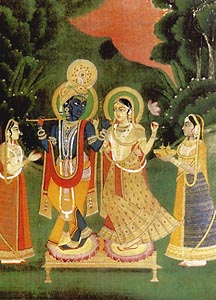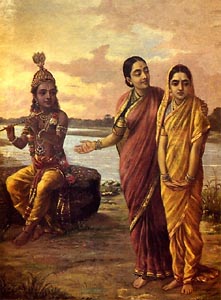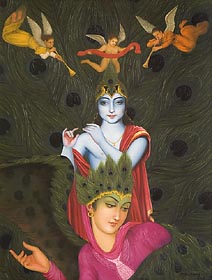| |
Raghu Vyas is an Indian artist, working in New Delhi . His
work is rooted in Indian cultural and artistic traditions,
while being informed by his study of the life and work of Raja
Ravi Varma and nurtured by formal designs drawn from the
Italian Renaissance.
The history of painting in India is
characterized by several major
 transformations,
each uniquely influenced by political and cultural
developments on the subcontinent .Vyas has studied and drawn from the rich heritage
of his country, and in a singular break
away from the canons of Modernism
that dominate the arts in 21st century India, he has provided
us an ardent, yet corpereal, portrayal of his beloved deity Lord Krishna . transformations,
each uniquely influenced by political and cultural
developments on the subcontinent .Vyas has studied and drawn from the rich heritage
of his country, and in a singular break
away from the canons of Modernism
that dominate the arts in 21st century India, he has provided
us an ardent, yet corpereal, portrayal of his beloved deity Lord Krishna .
An
early impetus
to painting in India
was the miniature art, beginning
under Mughal rule during the 16th century.
Miniatures were illustrative
paintings that were included in manuscripts or albums, commissioned by
the Shah . This Islamic styled art was brought to India
from Persia by the Mughal Emperors, and reached its zenith
during the reign of Akbar, between 1556 and 1605. Often painted in strong colors and a realistic style,
they depicted court life, military expeditions, a noble hunt,
or significant historic events. The Mughal Emperors at one
point controlled most of the Indian subcontinent . They were
tolerant of the Hindu culture and religion, and Mughal art
often included indigenous elements of Hindu culture. When the
central Mughal rule began
to decline at the beginning of the 18th century, many
artists left the Mughal court and subsequently became employed by
the provincial Rajas, forming ateliers. The themes of their illustrations
shifted to those strictly from Hindu culture. The miniatures
painted in the princely states in northern India are referred
to as
Rajput art, after the Rajput
warrior class that as allies of the Mughal rulers eventually
subjugated most of India . A popular theme for Rajput art
centered on the romantic stories of their Hindu god Krishna .
These miniatures exhibited a varying
degrees of stylization and included folk elements, using
the traditional symbolic
colors and iconography of Hindu culture.
Initially the art of India was isolated from the
influence of Western art. However, during the second half of
the
18th Century, British influence helped to establish salon
training in the art schools and art societies blossomed. Both
were in turn supported by the princely states. Several
Western artists associated
 with the Orientalism
movement
traveled to India to paint there. Among them were
Vasily V.
Vereschchagin
(Russian, 1842-1904),
Edwin Lord Weeks (American, 1849-1903)
and John Griffiths (Britain , 1838-1918). Itinerate salon
artists, many of them from Britain, traveled throughout India, looking
for commissions from expatriate Europeans and from the royal families. During this period,
an Indian artist,
Raja Ravi Varma (1848-1906), established himself by illustrating
the themes from
Indian mythology. Trained in Tanjore painting, Varma
researched the work of European masters and developed his
own techniques of oil painting. He studied prints of Italian and French
art in particular, through books and journals, and found
affinity with those who used theatrical gesticulation, ranging
from Baroque artist Il Guercino to academicians like Gustave
Boulanger and W.A. Bouguereau. Varma's work was soon distributed throughout
his country
in
oleographs (lithographic prints), and he became the most
well known artist in India during the last decades of
the 19th Century. The Ravi Varma Press, which was founded by him and his brother,
helped
popularize iconic images of Hindu mythology and
distribute them to even households of the lower castes . After his death, Varma's
critics largely discounted his contributions, condemning all
connections with European academic work. The first decades of
the 20th Century were marked by pervasive increases in nationalism,
and the rise of "swadeshi" artists. The development of indigenous oriental art, drawing from Mughal miniatures and
Japanese prints, is
broadly referred to as the
Bengal School, and is
considered India's first authentic art movement .By the mid 1920s,
this type of art was replaced by Modernism influenced by
Cubism, and art dealers began to
establish themselves in all of the major cities. Western styled avant-garde
painting became prominent, especially after India became an independent
state in 1949. with the Orientalism
movement
traveled to India to paint there. Among them were
Vasily V.
Vereschchagin
(Russian, 1842-1904),
Edwin Lord Weeks (American, 1849-1903)
and John Griffiths (Britain , 1838-1918). Itinerate salon
artists, many of them from Britain, traveled throughout India, looking
for commissions from expatriate Europeans and from the royal families. During this period,
an Indian artist,
Raja Ravi Varma (1848-1906), established himself by illustrating
the themes from
Indian mythology. Trained in Tanjore painting, Varma
researched the work of European masters and developed his
own techniques of oil painting. He studied prints of Italian and French
art in particular, through books and journals, and found
affinity with those who used theatrical gesticulation, ranging
from Baroque artist Il Guercino to academicians like Gustave
Boulanger and W.A. Bouguereau. Varma's work was soon distributed throughout
his country
in
oleographs (lithographic prints), and he became the most
well known artist in India during the last decades of
the 19th Century. The Ravi Varma Press, which was founded by him and his brother,
helped
popularize iconic images of Hindu mythology and
distribute them to even households of the lower castes . After his death, Varma's
critics largely discounted his contributions, condemning all
connections with European academic work. The first decades of
the 20th Century were marked by pervasive increases in nationalism,
and the rise of "swadeshi" artists. The development of indigenous oriental art, drawing from Mughal miniatures and
Japanese prints, is
broadly referred to as the
Bengal School, and is
considered India's first authentic art movement .By the mid 1920s,
this type of art was replaced by Modernism influenced by
Cubism, and art dealers began to
establish themselves in all of the major cities. Western styled avant-garde
painting became prominent, especially after India became an independent
state in 1949.
Raghu Vyas was born in Basohli, one of the early centers of
post-Mughal miniature art . His work has progressed through a
number of themes over the years, including
 his Lotus, Sikh and
Buddha series. The latest Krishna series adds to a level of
symbolism and virtuosity that transcends his earlier work, and
establishes a magnum opus for Vyas. his Lotus, Sikh and
Buddha series. The latest Krishna series adds to a level of
symbolism and virtuosity that transcends his earlier work, and
establishes a magnum opus for Vyas.
Included in the Krishna series are eighteen paintings, each one
a compelling romantic composition . The colors used are consistent
with the symbolic colors of the Pahari miniatures, painted in
the seventeenth century in what today is the state of Jammu.
The god Krishna is depicted as blue, signifying that he is an
aspect of the poisoned god Vishnu. Many of the paintings
incorporate traditional symbols associated with Krishna in Rajput art, such as the peacock, the flute and the goat . Vyas
uses naturalistic detail economically by blending imagery,
unified in harmonious, evocative compositions. His figuration
is graceful and naturalistic, in the sublime and noble style
of the
Renaissance Masters,
conjuring the spirits of
Giovanni Bellini,
Bernardo Luini,
Raphael, and
Leonardo. Still Vyas uses a floating poetic space
in many of these paintings, rather than traditional
perspective. And his Krishna radiates with the majestic poise
of the images of Krishna in the Rajput miniatures.
In several paintings, he employs a wide range of illusionistic techniques
in compelling trompe l'oeil, including displays of
bric-a-brac. This imagery employs the evocations of romantic
memories and yearning for Krishna . One immediately brings to
mind the "white magic" of the assemblages of Joseph Cornel .
In sum, the eighteen paintings bring us an ethereal beauty in
the classical style, while at the same time distilling the
passion and ethos of Hindu mythology. In returning to one of
the sources of prototypical beauty, Renaissance art, Vyas has shrewdly observed
that, in the Post Modern era of art, style is the servant
of content, and that this is a magnificent way to bring the
story of Krishna to the world both inside and outside of India .
Raghu Vyas Gallery
Artist's Web Site:
http://www.raghuvyas.in/
|
|